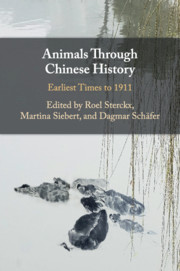Sare Aricanli is Assistant Professor in Early Modern and Modern Chinese History at the University of Durham.
Timothy H. Barrett is Emeritus Professor of East Asian History at the School of Oriental and African Studies, University of London.
Francesca Bray is Emerita Professor of Social Anthropology at the University of Edinburgh.
Vincent Goossaert is Professor at the Section des Sciences Religieuses of the École Pratique des Hautes Études (EPHE, PSL), Paris.
Han Yi is Professor and Research Fellow at the Institute for the History of Natural Science of the Chinese Academy of Sciences, Beijing.
Keith N. Knapp is Professor of History at the Citadel, South Carolina.
David Pattinson is Lecturer in Chinese Language and Literature at the University of Leeds.
Dagmar Schäfer is Director of Department 3, ‘Artefacts, Action and Knowledge’, at the Max Planck Institute for the History of Science, Berlin, as well as Honorary Professor, History of Technology, Technical University, Berlin; Adjunct Professor, Institute of Sinology, Freie Universität, Berlin; and Guest Professor, School of History and Culture of Science, Shanghai Jiao Tong University.
Mindi Schneider is Assistant Professor of Agrarian, Food and Environmental Studies at the International Institute of Social Studies (ISS) in The Hague, The Netherlands.
Adam C. Schwartz is Assistant Professor of Chinese Language and Literature and Associate Director of the Jao Tsung-I Academy of Sinology at Hong Kong Baptist University.
Martina Siebert works as area specialist for China in the East Asia Department of the Berlin State Library and as independent scholar.
Roel Sterckx is Joseph Needham Professor of Chinese History, Science and Civilisation at the University of Cambridge and Fellow of Clare College.
Mark Strange is Senior Lecturer in Chinese Studies at the Australian National University, Canberra.
Zheng Xinxian has recently completed her Ph.D. at Princeton University.
Book contents
- Animals through Chinese History
- Animals through Chinese History
- Copyright page
- Contents
- Figures
- Tables
- Contributors
- Acknowledgements
- Chronology of Dynasties
- Knowing Animals in China’s History
- 1 Shang Sacrificial Animals
- 2 Animal to Edible
- 3 Noble Creatures
- 4 Walking by Itself
- 5 Bees in China
- 6 Where Did the Animals Go?
- 7 Animals as Text
- 8 Great Plans
- 9 Animals in Nineteenth-Century Eschatological Discourse
- 10 Reconsidering the Boundaries
- 11 Animals as Wonders
- 12 Reforming the Humble Pig
- Bibliography
- Index
Contributors
Published online by Cambridge University Press: 08 December 2018
- Animals through Chinese History
- Animals through Chinese History
- Copyright page
- Contents
- Figures
- Tables
- Contributors
- Acknowledgements
- Chronology of Dynasties
- Knowing Animals in China’s History
- 1 Shang Sacrificial Animals
- 2 Animal to Edible
- 3 Noble Creatures
- 4 Walking by Itself
- 5 Bees in China
- 6 Where Did the Animals Go?
- 7 Animals as Text
- 8 Great Plans
- 9 Animals in Nineteenth-Century Eschatological Discourse
- 10 Reconsidering the Boundaries
- 11 Animals as Wonders
- 12 Reforming the Humble Pig
- Bibliography
- Index
- Type
- Chapter
- Information
- Animals through Chinese HistoryEarliest Times to 1911, pp. x - xiPublisher: Cambridge University PressPrint publication year: 2018
- Creative Commons
- This content is Open Access and distributed under the terms of the Creative Commons Attribution licence CC-BY-NC-ND 4.0 https://creativecommons.org/cclicenses/

